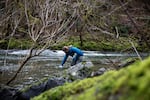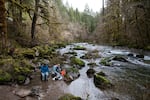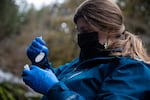
Research fish biologist Brooke Penaluna collects water samples from the Santiam River's south fork east of Cascadia, Ore., Wednesday, March 10, 2021.
Bradley W. Parks
Next to the babbling banks of the Santiam River’s south fork, Brooke Penaluna sought a flat spot to set up shop. She plopped down a black, pipe-like reservoir with four clear cups on top and clicked the power button on a small pump that sounded like the world’s tiniest lawnmower.
“And then we put on our gloves and our waders, and we go out into the stream,” said Penaluna, who works as a research fish biologist for the U.S. Forest Service’s Pacific Northwest Research Station.
Near the middle of the river, Penaluna carefully dipped four plastic bottles into the oncoming water, tightly capping them for the journey back to shore.
Inside those bottles, scientists are finding worlds of information that could be key to the long-term health of Oregon watersheds and all who share them.
With each scoop of water comes a trove of what’s called “environmental DNA,” or eDNA for short. Just like humans are almost constantly shedding skin cells, hair and other particles laced with genetic information, so are all the organisms in our waterways.

Penaluna pours river water into a filtering device to extract particles for eDNA analysis.
Bradley W. Parks
A few years ago, scientists were running tests to determine whether eDNA could reliably tell them who was living in Oregon’s rivers, streams, creeks, lakes and reservoirs. Turns out it can.
“We come out here and we can identify up to 900 different organisms in this river system,” Penaluna said.
Now, biologists are taking the science a step further. Scientists with Oregon State University and the Forest Service recently demonstrated they can use eDNA to analyze the genetic diversity of threatened salmon and trout, which can help us understand how they will adapt to climate change and other threats.
“The more variable the organisms are, the greater ability they have to be flexible and adapt and change into the future,” Penaluna said.

Penaluna and Kevin Weitemier filter samples of river water on the banks of the Santiam River's south fork.
Bradley W. Parks
OSU and the Forest Service published their findings in the journal Molecular Ecology earlier this year.
Kevin Weitemier is a research associate with OSU and led the study.
“It’s really important that we understand the genetic diversity, particularly,” Weitemier said. “We focused on trout and salmon populations in the Northwest to help our managers effectively manage these populations and maintain the diversity that can help keep robust populations in place.”
The study focused on four species — coho and chinook salmon, rainbow trout or steelhead, and coastal cutthroat trout — at 16 different sites across five watersheds — Deschutes, Klamath, Rogue, Umpqua and Willamette (the Santiam is one of its tributaries).
They found, for example, that smaller coastal rivers hosted some of the most genetically diverse populations of cutthroat trout. Penaluna said researchers also found unique genetic variants of certain species in the Umpqua River.
They uncovered genetic similarities in rainbow trout from the White River, which runs from Mount Hood east past Tygh Valley, and trout from the Klamath River. Some have long theorized the Deschutes and Klamath watersheds were once connected by an intermediary basin called Fort Rock, and this provides a piece of evidence.
Collecting this type of genetic information typically requires capturing fish by electro-shock or angling, then clipping a fin, Weitemier said. It usually doesn’t kill the fish, but it’s also not great for them.
“If we can get a sense of what’s happening with the genetic diversity of the population from just a couple bottles of water, that’s a really big advantage,” Weitemier said.

Penaluna removes a filtering wafer covered in particles for eDNA analysis.
Bradley W. Parks
Back on the riverbank, Penaluna poured river water little by little into the four cups atop the pipe-like contraption. As the water filtered through the system, it left behind teensy specks on a gridded wafer at the bottom of the cups. Those leftovers were what she was after.
No fish showed themselves in the Santiam while Penaluna sampled, but because of how eDNA lingers in waterways, she said, you don’t necessarily need to even see a fish to know it’s there. That’s one of the method’s main draws. It also requires smaller field crews.
“eDNA allows us to sample for a broad range of organisms within our water systems without harming any of the animals or plants that we’re interested in focusing on,” Penaluna said.
Research has proven eDNA’s effectiveness in detecting species presence and absence, Penaluna and Weitemier said, but its application on genetic diversity is still new.
“We think it’s working pretty well in our salmonids,” Weitemier said, “but it differs for different organisms, so we’re continually doing tests to try and suss that out and refining our techniques to improve those.”
Researchers intend to expand the application of eDNA analysis to other species. If it proves as cheap, efficient and effective as proponents say it is, eDNA could become a critically important tool to monitor the health of Oregon watersheds into the future.
